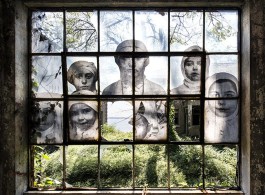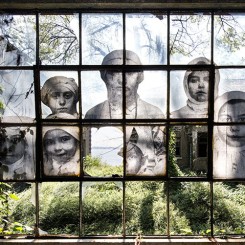Galerie Perrotin, Hong Kong is pleased to present, “Ghosts of Ellis Island. An Unframed Project, Short Preview” an exhibition of works which document French artist JR’s latest Unframed project—a permanent installation which animates, enlivens and offers unprecedented access to New York’s Ellis Island Immigrant Hospital.
Open to the public for the first time since 1954, the Ellis Island Immigrant Hospital facilitated the passage of a massive wave of immigration to the United States from 1902 to 1930. All told, over a million patients deemed too ill for immediate naturalization would pass through its walls. Having to screen for and treat a veritable catalogue of diseases from around the world would transform the hospital, the first public health facility in the country, into a test-case for then state-of-the art sterilization and diagnostic procedures. The program proved effective, though following tightened restrictions on immigration in the 1930s, the facility was repurposed to house disabled soldiers and, later, as a detention center for Axis prisoners following the Second World War. In 1954, outmoded and disused, the Hospital was shuttered, abandoned, and, until recently, largely forgotten.
Today, the Ellis Island Immigrant Hospital stands much as it was abandoned; but after sixty years of silence and disrepair, local vegetation has begun to reclaim the grounds, introducing grass and vine to what must’ve once been a starkly modern facility. As the former setting for the confluence of illness and recovery, health and death, of prisoners and heroes, aspirations and disappointments, if any place might be said to be haunted, Ellis Island Hospital certainly meets all criteria. And it is from this heavily charged genius loci that JR, in coordination with Save Ellis Island, has undertaken “Unframed – Ghosts of Ellis Island.” As with previous Unframed projects (Grottaglie, Italy (2009), Vevey, Switzerland (2010), Sao Paulo, Brazil (2011), Washington, USA (2012), Marseille, France (2013)), JR does not compose his own photographs, but instead recuts existing photography, excising figures and portraits from their frames to recompose them in unexpected locales and public settings. The overall effect is equal parts stagecraft and public art, recalling the original photographs while redeploying them in such a way as to give them new life on confrontation with their viewers. With “Ghosts of Ellis Island” the manner in which the original subjects of JR’s source material are granted new life is perhaps even more direct: Culled from hospital archives, JR has repopulated the hospital with its former inmates, rendering its “ghosts” present and visible, and, in so doing, de-mystifying the very real sense in which the hospital is haunted with its own redolent history. Here, JR is less the artist as historian than he is artist as exorcist or ghost-seer, reconciling past, present, and viewer in artful communion.
On display in the present Hong Kong exhibition are four images taken from “Unframed – Ghosts of Ellis Island,” which serve to preview the New York project. All four images evince JR’s unique curatorial eye and talent for mise en scène. An organic sense for composition and lighting is matched with a talent for discovering and re-exposing the most immediately emotive of expressions and figures. In one image, through the remains of a multi-paned window, we are greeted by the sunlit faces of seven child patients, their hair wrapped, their expressions muted, their parents nowhere in sight. In another image, a sullen young woman is reinstalled on the wall behind his now rusted sickbed; she looks at us impatiently, even angrily, while an older woman, maybe an aunt or an older sister, sits at the foot of her bed disconsolate. The two of them blend into the crumbling discolored plaster as if exposed by careful excavation rather than having been applied by the artist after the fact. Elsewhere, a clan of dark-featured, prominent-eared immigrants poses stiffly, seriously for their portrait; they sit together, as if on a long bench, waiting by a ruined entrance to the hospital, the door still ajar. But in perhaps the most hopeful, though also potentially the most mournful image on display, the silhouettes of a small family can be seen standing just outside a floor length window; with their backs to us, husband, wife, and child look across New York Harbor at a distant Statue of Liberty. In another setting, a scene of this sort, so loaded with well-worn symbols, might come off as cliché or outright propagandistic; but rather than toning it down, JR has embraced the iconography, making deft use of the greatest advantage of his practice: reality. The Statue of Liberty in JR’s composition just is the Statute of Liberty; the window through which we are looking at her just is the window through which countless immigrants looked out at her too; and the little family before us truly was there, and remains there, still haunting the old hospital as three of the ghosts of Ellis Island.
Beginning his artistic career at the age of 17, JR happened upon a camera on the Paris subway and began pasting portraits in the eastern suburbs of Paris, Montfermeil, Les Bosquets.
Since then, JR creates monumental photographs that he pastes around the world, infiltrating in urban life anonymous portraits, witnesses of the present and the past – “Women are Heroes” in Rio de Janeiro, Jaipur, Nairobi (2008-2010), which gave its title to JR’s movie that was selected at the Festival de Cannes in 2010 ; «The Wrinkles of the City» in Cartagena, Shanghai, Los Angeles, La Havana, Berlin and Istanbul (2008-2015).
JR reveals art by action, displaying his gigantic prints over the suburban buildings of Paris (“28 Millimètres, Portrait of a Generation”, 2004-2006), on walls in the Middle East (“Face 2 Face”, 2007) or in the United States, in the favela Morro da Providencia in Brazil (“28 Millimètres, Women Are Heroes”, 2008) or on the roofs in Kibera, Kenya (“28 Millimètres : Women are Heroes”, 2009), on the facade of Tate Modern in London…
He received the prestigious TED Prize in 2011 that offered him to make a “wish to change the world”. With the INSIDE OUT Project, JR brings together and prints portraits, as messages of personal identity (www.insideoutproject. net). On this occasion, photobooths printing large-scale self-portraits were seen during the summer in various places of the globe, including Paris (Centre Pompidou, Galerie Perrotin), Arles (Rencontres de la Photographie), Tel Aviv or Ramallah, and Hong Kong at Galerie Perrotin in 2012 ; furthermore photobooth trucks travels around the world such as in Japan (2011), Amsterdam, London, at Times Square, NYC, at Palais de Tokyo, Paris (2013), around Shanghai in 2014, etc. Solo shows of JR’s work have been exhibited in galleries and museums worldwide, including The Rath Museum in Geneva, Tokyo’s Watari Museum, The Contemporary Art Museum in Dallas, The Contemporary Arts Center in Cincinnati, the Museum Frieder Burda, Baden-Baden, Germany, Power Station of Arts in Shanghai, and “Au Panthéon”, a monumental installation surrounds the drum of the Pantheon’s dome until the end of its renovation.
Simultaneously, JR’s “A Survey exhibition” is organized by the Hong Kong Contemporary Art Foundation (HOCA), at Repulse Bay, The Ocean, 3/F, 28 Beach Road, Hong Kong from 15th of March until 12th of April 2015. On this occasion, a catalogue has been published with a text by the curator Lauren Every-Wortman.
Galerie Perrotin, Paris will present an important solo exhibition by JR in September 2015.
A book created with Art Spiegelman “The Ghosts of Ellis Island” will be launched in April 2015.


